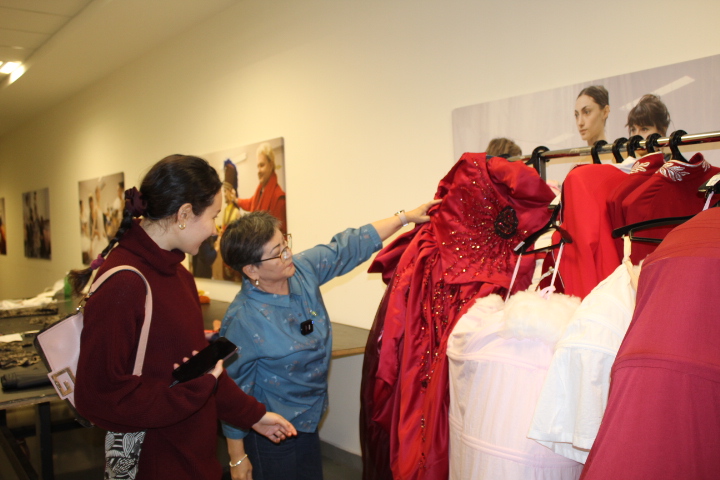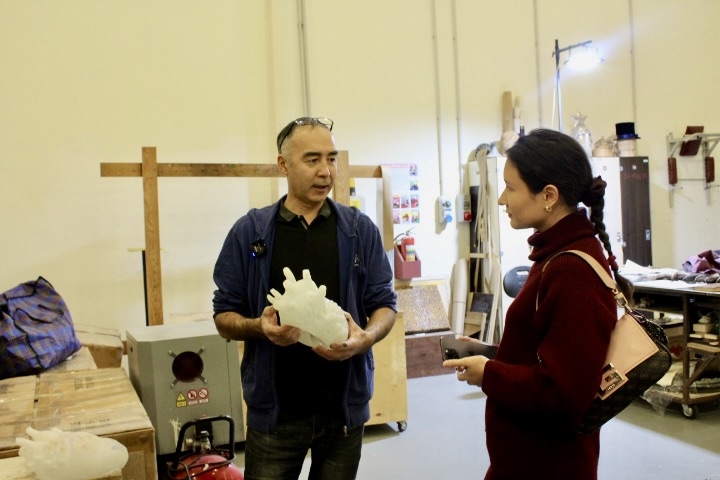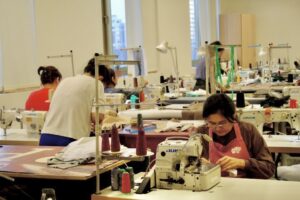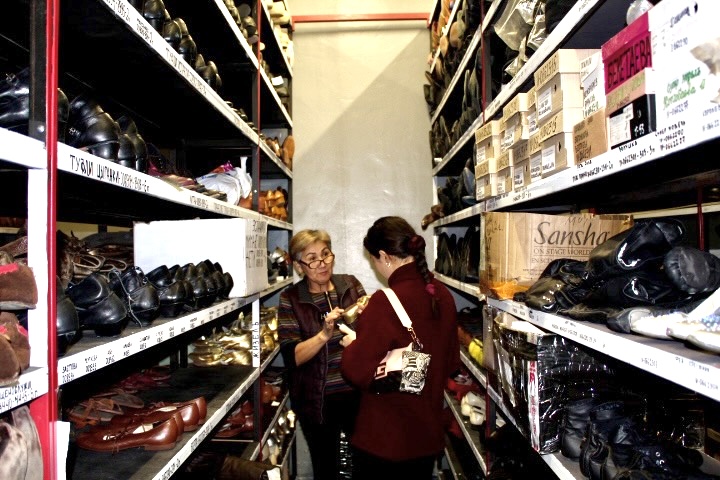ASTANA – Behind the red curtains of Astana Opera is a universe of dedicated crew who work tirelessly to ensure that every costume fits perfectly, every makeup and prop enhances the performance, and every scene transition is executed smoothly.

Head of the sewing department, Fatima Satybaldina, shows The Astana Times correspondent the intricate details of a soloist’s costume from the recent premiere of “Orlando Furioso” opera. Photo credit: Aida Dosbergenova/The Astana Times
The Astana Times correspondent spoke with faces who make up the backbone of the theater community: costume designers, sewers, wardrobe dressers and prop-makers to bring them out of the shadows. Each of them has a story to tell of their experience: inspiring tales of hardship, innovation, late hours and immense joy from bringing to life what once was just an idea.
Setting the scene: costume and scenic design
With opening night for a new comic opera, “Aisulu,” set for Nov. 29, rehearsals are full on. The Astana Times was given a backstage pass to document what it takes to stage an opera production in the theater.

Pavel Dragunov talked about the details of costume and scenic design for the upcoming premiere of “Aisulu” opera. Photo credit: Aida Dosbergenova/The Astana Times
The “Aisulu” opera follows Serke, a young man from a rural village, as his journey to the city intertwines with the story about an inspiring young woman Aisulu, leading to romantic misadventures, playful tricks, and a joyful celebration of love in the village.
Costume and scenic designers Sofya Tasmagambetova and Pavel Dragunov created a unique stage space that vividly captures the essence of Kazakh youth during the 1960s Soviet era.
“Our task here was to create a kind of time machine to transport the audience back to the 1960s. We tried to recreate the atmosphere and emotions as authentically as possible. In essence, this opera would be a ‘balm for the soul’ for an older audience, you could say. For them, it’s a chance to immerse themselves, to relive their youth. I think it will be very captivating,” said Dragunov to The Astana Times.
Dragunov, together with Tasmagambetova, has previously worked with Astana Opera on the “Karagoz” ballet, “Kyz Zhibek,” “Birzhan-Sara,” “Turandot” and “Eugene Onegin” operas. According to him, there is a major difference between designing costumes for ballet and for an opera.
“Ballet costumes are fundamentally different from opera costumes. They have different requirements, different purposes, and a completely distinct aesthetic. Comfort is essential. In opera, there’s much more freedom of expression and fewer restrictions. In ballet, options are very limited – the fabric has to stretch, the leg has to lift, and the costume should not be too heavy,” said Dragunov.
Props department
Further across the hidden hallways and workshops of Astana Opera, we uncover the props department, where everyone is busy crafting everything needed for the stage—from apples and suitcases to a life-sized cow.

Prop-maker Yerzat Yelshibayev is holding a hand-made heart used as a prop for “Orlando Furioso” opera. Photo credit: Aida Dosbergenova/The Astana Times
Prop-maker and craftsman Yerzat Yelshibayev has been working with Astana Opera since its opening. He shared the secrets of designing and building the props – work that is hard, and often not glamorous.
“We always start from negotiations with scenographers and production directors on what they need for the scene,” he said.
They use a variety of materials such as metal wire, wood, foam plastic and papier mache to make props for productions that throw some particularly unusual dilemmas.
“We always find a solution. Sometimes, it involves building a mechanism inside, so we brainstorm and research. We dive into books and archives to match the historical period of each object. With years of experience, you start to know the process instinctively, but every production brings a new prop to tackle,” said Yelshibayev.
Among the most challenging productions for Yelshibayev, preparations for the “Kyz Zhibek” opera were no small feat, with all the department members working hard for several months to ensure that the props were perfect and the characteristics of the time were spot-on.
“In ‘Kyz Zhibek,’ there are massive scenes with a lot of extras, so we made a lot of spears, swords and bows. We did all the props ourselves,” said Yelshibayev.
Sewing department
Turning yet another corner, we stumble upon a tailoring and sewing department. The workspace is filled with costumes at various stages of completion. Every costume is crafted in-house at Astana Opera by a dedicated team of 23 women. With sewing deadlines averaging 1-1.5 months, they put in an immense amount of effort to bring each piece to life.

Every costume is crafted in-house at Astana Opera by a dedicated team of 23 women. Photo credit: Aida Dosbergenova/The Astana Times
Head of the tailoring department, Fatima Satybaldina, walks through the peculiarities of making costumes for ballet and opera.
“For example, if we’re making costumes for opera when we do a fitting, we always ask who’s singing. Especially for the lead performers, we make the chest area looser so they can breathe properly and support their voices as needed. We make their costumes with a bit more freedom, just as they request,” said Satybaldina.
“But ballet is entirely different. Ballet is for dancers, so we have to consider every movement – the movement of the arms, the legs, everything. There are many details to ensure they can lift their arms, sit on the floor in a split so that the clothing allows for a full range of motion without restricting them,” she added.
Asked about the production that required handling the largest workload, Satybaldina said there were many, but one performance particularly stood out.
“One of the most demanding was the ‘Kyz Zhibek’ opera. There were 360 costumes for that – lots of costumes. We had children, the choir, and ballet involved; the entire creative team participated,” said Satybaldina.
“As for complexity in ballet, ‘Manon’ stands out and ‘Cinderella,’ which we did just a couple of years ago. For ‘Cinderella,’ we collaborated with an outstanding designer who actually performed in ballet himself and now works in high fashion. Working with him was very smooth, but the costumes were incredibly intricate, with detailed cuts and finishes. It was a high-fashion production,” she added.

The costumes and set design in “Aisulu” captures the essence of Kazakh youth during the 1960s Soviet era. Photo credit: Aida Dosbergenova/The Astana Times
Now, the team is working hard in preparation for “Aisulu.” Satybaldina mentioned nuanced complications that come with staging Aisulu’s story.
“Men’s costumes here are particularly challenging because they’re mostly suits – we’re making jackets for the entire choir and for the soloists as well. It’s a very complex and labor-intensive costume, with so many pockets, interfacing, padding, all of it, down to the smallest details. So our team works tirelessly, ‘from bell to bell,’ you could say,” Satybaldina said.
Costume department
Next on our backstage tour is the costume department: a treasure trove of costumes, where rolls of cloth and tutus in a myriad of colors are neatly arranged in a way only the staff truly understands. It is a strangely peaceful oasis after the extensive journey to reach it.

The costume department at Astana Opera is huge, housing over 10,000 costumes for nearly 50 productions. Photo credit: Aida Dosbergenova/The Astana Times
Senior dresser Zhadyra Kutzhanova has dedicated a quarter of a century to this work.
“We prepare for the performance seven days in advance due to the large number of costumes. If an artist has three costume changes during a performance, we’re looking at 120-140 costumes in total. We handle every one of them—sometimes, a single person has 6-8 outfits. We iron, wash, clean, sew, and make minor repairs,” said Kutzhanova.
She knows this is a work that needs to be treated with great sophistication and care.
The costume department at Astana Opera is huge, housing over 10,000 costumes for nearly 50 productions in the theater’s repertoire. A watchful eye would notice that each section is labeled with the names of various operas and ballets, while the costumes are marked with the names of the soloists.
“The temperature here will be between 20-23 degrees [Celcius]. Some of our costumes have been in stock since 2000, and their quality is exceptional because we take great care of them. We have 16 costume specialists, each an expert in their field, ensuring everything is well-maintained,” said Kutzhanova.
Shoe department
Passing through another labyrinth of theatrical corridors, we finally reach the shoe department. Here we are greeted by its head, Maiken Kadyrova. She attends to hundreds, if not thousands, of carefully organized shoes. Kadyrova has been working as a shoe supervisor for 25 years, and her face lights up when she talks about her craft. She quickly traverses the room, grabbing at shoes and pointing out details.

Shoe supervisor Maiken Kadyrova’s face lights up as she points out every detail in differences between ballet and opera shoes. Photo credit: Aida Dosbergenova/The Astana Times
“If an artist is shorter in height but has an amazing voice, they would make custom shoes for them. For example, hidden heels—say, boots or shoes—would be made with a heel of around five centimeters. On the outside, they would also be slightly raised. With the platform, they would end up around seven centimeters taller. Only we knew about this,” said Kadyrova.
The enormous pile of pointe shoes lies in one of her cabinets – a stark reminder of the physical toll every ballet performance takes.
“Now, they make them (pointe shoes) from a polyurethane material that is practically indestructible. This material doesn’t burn, break, or sink. Over time, the fabric around it wears out and tears, and that’s when we retire the shoes. They go through quite a bit of use. They do fouetté 32 times and sometimes multiple times in a row, sometimes even dozens of times. Of course, they wear them for about three months. Our primadonnas, though, their shoes are often the first to go,” said Kadyrova.
“When they go to warm up or to any rehearsal, they carry a backpack with around 10 pairs of pointe shoes. They spend the first half hour putting on one pair, then the next half hour putting on another. Throughout the day, they use all ten pairs. They can’t just be left to dry; they need to be in constant use. That’s how it works,” added Kadyrova.


